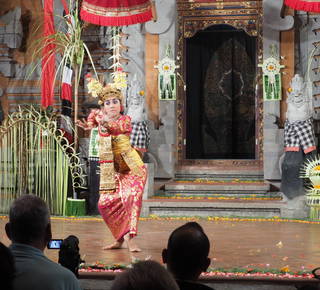Yesterday I set Helen up with the iPad, only to have her come to me after five minutes saying "Enough iPad, I want to watch some Legong Dance". And so we watched nearly an hour of Legong Lasem and Barong Taru Pramana.
I had listened to a little bit of Balinese music as preparation before our trip to Bali. (I have probably only been to three or four performances, of the Sydney-based Sekaa Gong Tirta Sinar, and my own gamelan listening is almost entirely Javanese.) And in Sydney I watched the Attenborough documentary The Miracle of Bali, some of if with Helen and her cousins. (Her favourite part is the section about the mask-maker in The Midday Sun.) Then in Bali we went to a Legong dance performance in Peliatan, a village just outside Ubud (coincidentally, the village that features in the Attenborough documentary). Here's the program from the performance, with some links to YouTube.
- Instrumental: Sekar Gendot (Sekar Jepun)
- Puspa Mekar (Lambangsari)
- Legong Lasem
- Kebyar Terompong
- Legong Jobog
- Barong Taru Pramana
Helen was quite taken by this, both at the time and on YouTube afterwards (strangely, at least to me, she prefers the more stylised legong dance to the more dramatic barong operetta) and there has been a bit of cross-media reinforcement. On our last day in Ubud we went to the Neka museum, where some of the painting and photographs are of dance scenes. At the airport on the way home we picked up a copy of Tari: The Little Balinese Dancer, which I think does a rather lovely job both in conveying something of Balinese culture and in dealing with the difficult theme of a grandparent's death — is also a favourite of Helen's (and it was her pick in the bookshop, too). And soon after getting back home we acquired a dragon lion puppet for Chinese New Year, which is so similar to the barong it must surely be related in some way.


